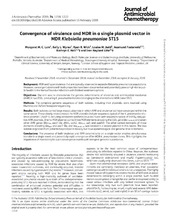Convergence of virulence and MDR in a single plasmid vector in MDR Klebsiella pneumoniae ST15
Lam, Margaret M.C.; Wyres, Kelly L.; Wick, Ryan R.; Judd, Louise M.; Fostervold, Aasmund; Holt, Kathryn E.; Löhr, Iren Høyland
Peer reviewed, Journal article
Published version

Åpne
Permanent lenke
https://hdl.handle.net/1956/23784Utgivelsesdato
2019Metadata
Vis full innførselSamlinger
Originalversjon
https://doi.org/10.1093/jac/dkz028Sammendrag
Background: MDR and hypervirulence (hv) are typically observed in separate Klebsiella pneumoniae populations. However, convergent strains with both properties have been documented and potentially pose a high risk to public health in the form of invasive infections with limited treatment options. Objectives: Our aim was to characterize the genetic determinants of virulence and antimicrobial resistance (AMR) in two ESBL-producing K. pneumoniae isolates belonging to the international MDR clone ST15. Methods: The complete genome sequences of both isolates, including their plasmids, were resolved using Illumina and Oxford Nanopore sequencing. Results: Both isolates carried large mosaic plasmids in which AMR and virulence loci have converged within the same vector. These closely related mosaic hv-MDR plasmids include sequences typical of the K. pneumoniae virulence plasmid 1 (KpVP-1; including aerobactin synthesis locus iuc) fused with sequences typical of IncFIIK conjugative AMR plasmids. One hv-MDR plasmid carried three MDR elements encoding the ESBL gene blaCTX-M-15 and seven other AMR genes (blaTEM, aac3'-IIa, dfrA1, satA2, blaSHV, sul1 and aadA1). The other carried remnants of these elements encoding blaTEM and aac3'-IIa, and blaCTX-M-15 was located in a second plasmid in this isolate. The two isolates originated from patients hospitalized in Norway but have epidemiological and genomic links to Romania. Conclusions: The presence of both virulence and AMR determinants on a single vector enables simultaneous transfer in a single event and potentially rapid emergence of hv-MDR K. pneumoniae clones. This highlights the importance of monitoring for such convergence events with stringent genomic surveillance.
